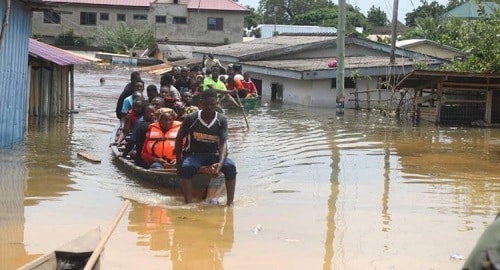Over 30,000 residents along the Volta basin have been displaced after their communities were submerged in flood waters from the Akosombo and Kpong Dams spillage.
In September 2023, the Volta River Authority (VRA) announced its intentions of a controlled spill of the Akosombo and Kpong dams.
The authority said the spill is crucial due to a “consistent rise in the inflow pattern and water level” to ensure the safety of the Akosombo Dam. In their quest to protect the dam, many communities have suffered various degrees of the spill’s aftermath.
In this report, Fact-check Ghana explains the number of times Ghana has experienced dam spillage and its aftermaths.
On October 9, the VRA in a statement stated that it noted that the dam’s reservoir was getting too high and had almost reached the maximum safe level of 277.5 feet, hence the decision to intensify the spill rate.
Deputy Chief Executive, Engineering & Operations at VRA, Ing. Edward Ekow Obeng-Kenzo, in an interview on JoyNews, disclosed that this year’s spill is comparable to the spill that occurred in 1967 due to its devastating effects.
The Akosombo dam is Ghana’s biggest hydroelectric power producer with a capacity of 1,020 megawatts of hydroelectric power.
The spillage of the Akosombo dam is not peculiar to this year. Even though it is not a perennial incident, it occurred in 1966, 1967, 1968, 1969, 1970, 1971, 1972, 1974, 1991 and 2010.
VRA reveals that as of Wednesday, October 25 2023, the Akosombo lake level was 277.21 feet (84.493 metres). This is 0.29 lower than its maximum level of 277.5 feet.
The VRA maintains that it cannot tell specifically when the spill exercise will end. However, it has intensified its humanitarian efforts to support affected communities.
Residents living in the Asuogyaman, Shai Osudoku and Ada East Districts in the Eastern and Greater Accra Regions; in the North, Central, South Tongu and Anlo Districts in the Volta Region have been affected by the spillage.
Two weeks after the spillage submerged the lower Volta basin, some communities upstream also began to experience floods.
Pru East District of the Bono East Region, Nkwanta-North District, Kete-Krachi in the Krachi-West Municipality, Tapa-Abotoase in the Biakoye District and Dambai in the Krachi-East Municipality and the capital of the Oti Region all have been engulfed in flood waters from the Akosombo dam along with heavy rains.
Farmers, households and businesses in the affected areas are counting their losses, as the water has washed away their farms, properties and goods.
Weija Dam Spillage
It can also be recounted that the southwestern part of Accra occasionally experiences floods from spillage of the Weija dam operated by the Ghana Water Company Limited (GWCL).
The Weija Dam covers a total area of 20.5 km2 with an effective storage capacity of 133 million m3. It has five spillway gates for occasional spilling when the water level rises beyond 47ft.
The GWCL also says the spillage of the Weija dam and other dams across the country occurs to prevent considerable havoc to its water treatment plants.
The rise in settlements around the Weija Dam leading to encroachment of the dam’s buffer zone has also contributed to the persistent flooding in the area.
Although residents have complained about the dam spillage in Weija, Managing Director of the Ghana Water Company Limited, Dr Clifford Braimah, has blamed encroachers of the buffer zones for the flooding in the area.
Almost every year, residents living in communities such as Tetegu, New Weija, SCC, Tatop, Sampa Valley among others become victims of the spillage with the most recent in October 2022. (See 2014, 2015, 2017, 2020, 2021, 2022)
In 2022, the Greater Accra Regional Coordinating Council reported that 500 people were displaced due to the Weija dam spillage. The highest in the history of the dam.
Bagre Dam Spillage
Some Ghanaians living in the Upper East Region have suffered the ripple effect of the Bagre dam spillage located in Burkina Faso.
The spillage of the Bagre dam takes place in August or September every year to maintain the dam’s 235-metre water holding capacity and prevent destruction to the dam.
Upper East Regional Coordinator for National Disaster Management Organisation (NADMO), Jerry Asamani, told Fact-Check Ghana that 1,364 people were displaced in 2022 due to flooding from the Bagre dam.
On September 5, 2023, the VRA, in a statement indicated that the power utility of Burkina Faso, SONABEL, had announced that the Bagre Dam had recorded high inflows, requiring spillage of water from the dam.
On September 16, 2023, the Bagre dam spill commenced. According to Mr. Asamani, the spill was termed as ‘management spillage’ because only the spill gates were interchangeably open.
This, he said, had minimal impact on the flood-prone communities in the region.
Bawku West, Garu, Binduri, Nabdam and Talensi Districts as well as communities situated along the Oti River, such as Dambai, Kete-Krachi, and some remote areas often witness varying degrees of destruction because of the dam’s spillage.
He earlier stated in an interview with Ghana News Agency that one of the spill gates of the dam was opened in the later part of August, flooding various farmlands in the communities.
Reports have also shown that some people have died due to past spillages of the Bagre dam. “10 people were killed in 2014; 34 were estimated dead in 2018 and six in 2020,” the Ghanaian Times reports.



